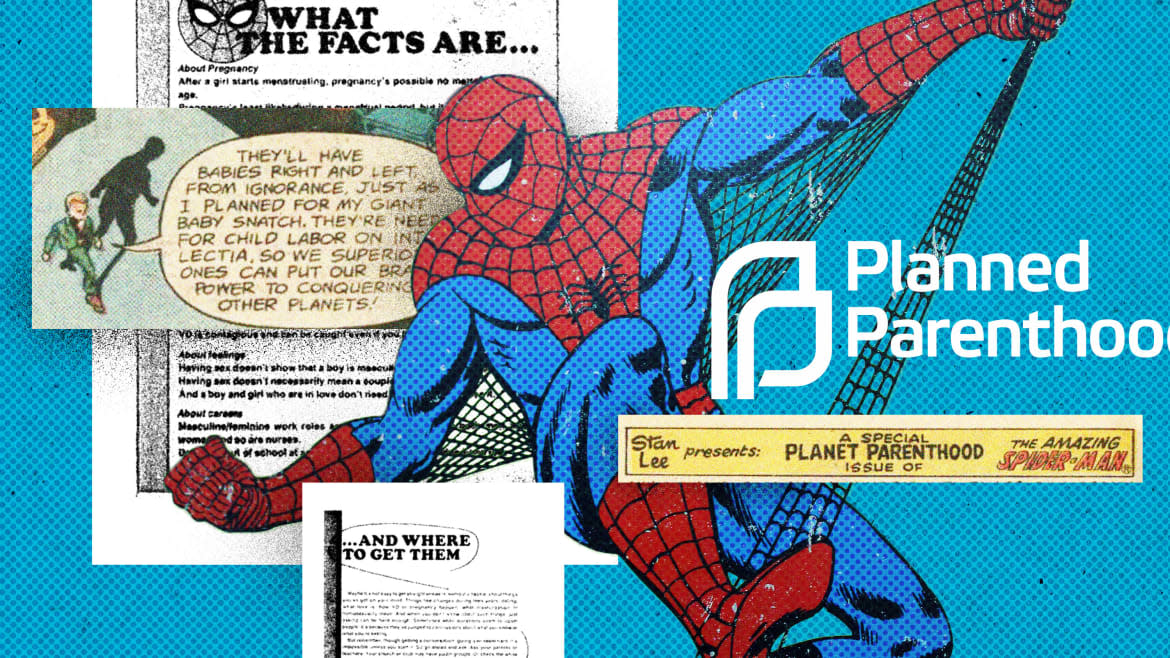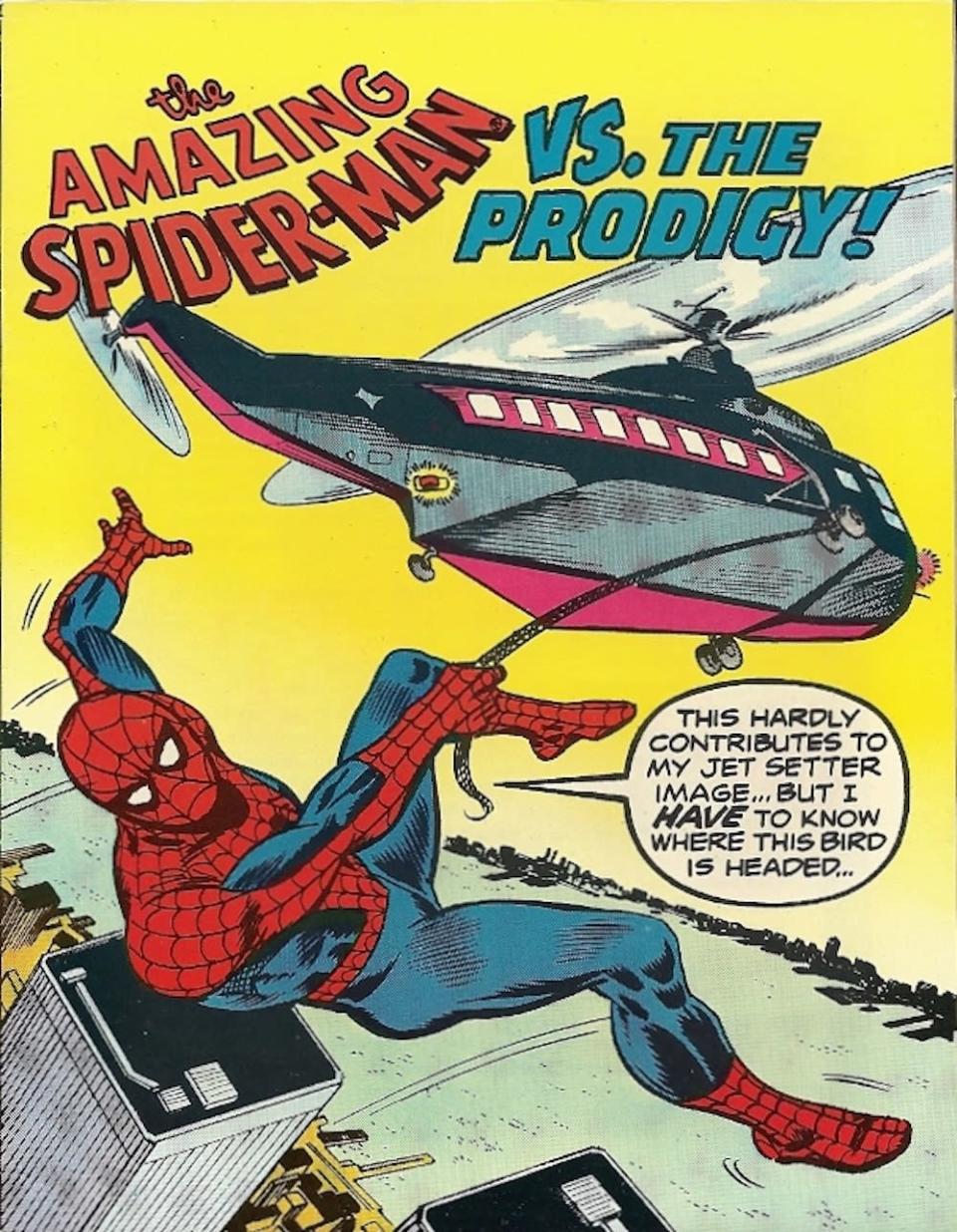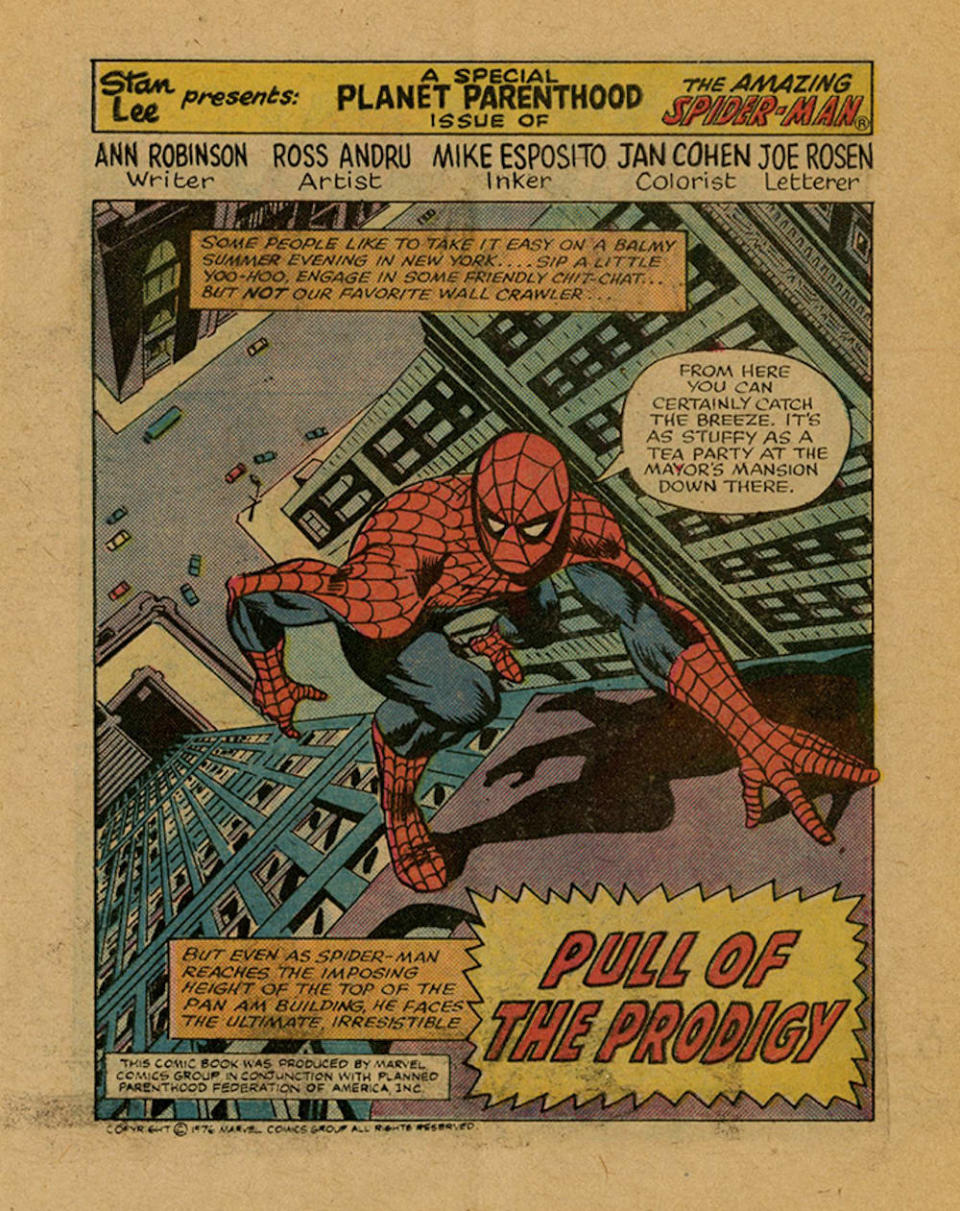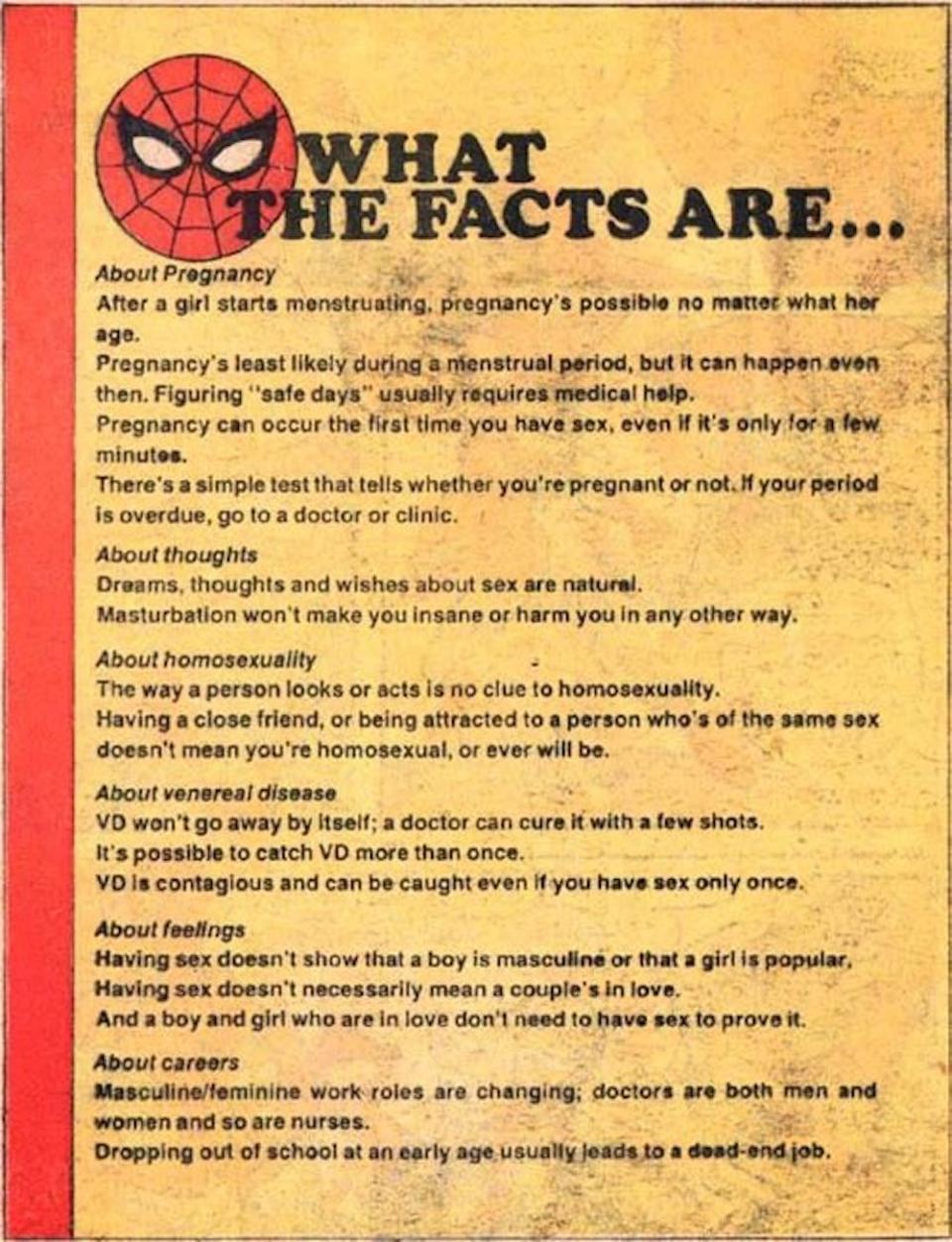When Spider-Man Teamed Up With Planned Parenthood to Stop a Forced Pregnancy Alien

There are certain things you expect to see in the Spider-Man comics of the 1970s. Battles with animal-themed villains. Romantic drama amidst the glamorous supporting cast. Secret-identity shenanigans. What you probably wouldn’t expect to see: Spider-Man foiling a dastardly plan to spread misinformation about sex, in a comic sponsored by Planned Parenthood.
The year: 1976. The Sexual Revolution was in full swing. Roe v. Wade had been decided three years prior, temporarily enshrining national abortion rights. The nation was now openly grappling with the existence of teen pregnancy, with the phenomenon covered in places like LIFE magazine. Worrying reports of a rise in teen pregnancy numbers led reproductive rights organizations to try and raise awareness about the problem—and someone at Planned Parenthood hit upon the idea of commissioning a free pamphlet from Marvel Comics. The result: The Amazing Spider-Man vs. The Prodigy, a 16-page comic written by Ann Robinson, in charge of the company’s licensing, and drawn by the regular Amazing Spider-Man art team of Ross Andru and Mike Esposito.
Our story begins with a green-skinned, big-headed alien named The Prodigy, who plans to brainwash America’s kids into pumping out children, all to fuel the child-labor needs of the planet Intellecta. (He can do this, a hilariously long editor’s note explains, because cosmic radiation has rendered his voice hypnotic.) “Imagine,” the Prodigy gloats to the reader, “[teens] really think you can’t get pregnant before you’re 15, or the first time you have sex, if you only do it once in a while. They’ll have babies right and left from ignorance, just as I planned for my giant baby snatch.”

What the Prodigy hadn’t planned on, however, is Spider-Man following the helicopter he’s sent out to bring impressionable teenagers to his secret mansion. The suspicious wall-crawler lurks outside the window, watching as The Prodigy—wearing, naturally, a rubber human mask—lays out his spiel. “They’re just trying to scare you into thinking it’s easy to get pregnant,” he tells the kids. “But I say, how else can you prove you’re a man; how else are you going to get a man? Your babies won’t be a burden…they’ll be brought up by experts. After all, they’re important.”
Spider-Man is naturally disgusted. “This guy’s plan is to keep kids from getting the facts,” he tells the reader. “He wants them to be baby machines! Changing diapers. Going nowhere in dead-end jobs…sitting home every night trying to find the time and the money to go to a movie or buzz out to the burger stand! What kind of life can they live?”
The Prodigy has bigger plans, however—he’s going to go on national television and give the same speech to the entire nation. Enter: Spider-Man, who dusts him and his henchmen up and pulls the rubber mask off, exposing the wicked plot and saving America’s teenagers from alien-fueled misinformation.
John Oliver Rages Against Dems’ Embarrassing Roe v. Wade Response
While “The Amazing Spider-Man vs. The Prodigy” might seem like an unusual artifact, it actually represents a common side-business of mainstream comics publishers: publications starring popular characters, commissioned by governmental organizations, nonprofits, and private companies. Some of these are pure commercial advertisements—who could forget the narrative masterpiece that is 2012’s Craftsman Bolt-On System Saves the Justice League?—but others functioned as PSAs, some of which went to extremely wacky places.
According to Douglas Wolk, a journalist who writes on comics, the Planned Parenthood-commissioned comic was actually an early example of the form for Marvel. In the 1980s, the company published several more. Some, like an anti-smoking comic starring Spider-Man, Storm, and Luke Cage for the American Cancer Society, were steadily reprinted. Others have subsequently (and unfairly) been the subject of internet infamy, particularly Secrets, a 1984 Spider-Man story commissioned by the National Committee For Prevention Of Child Abuse—which featured Peter Parker revealing that he’d been sexually abused by an older man. (In 2011, Marvel announced a collection reprinting many of the PSAs, including The Amazing Spider-Man vs. The Prodigy and Secrets, but for whatever reason only ended up releasing the anti-drug ones under the title Amazing Spider-Man Fights Substance Abuse.)
“Spider-Man gets used in these PSAs a bunch because he’s a recognizable character,” Wolk said. “He’s one of the most human, most normal, not rich or special ones… he’s the character that kids could identify with. But he’s also a familiar character, and the point is to get a familiar character as a hook to get kids to pick a thing up and read it.”

Commissioned comics were, in fact, able to tackle subjects many mainline comics throughout the 1970s shied away from—such as substance abuse and teen pregnancy, Wolk said. Comics at this time were regulated by the Comics Code Authority, an institution formed by large publishers to head off governmental regulation in the 1950s. Carrying the approval of the CCA wasn’t a legal requirement, but you did need it to be sold on newsstands. Since Amazing Spider-Man vs. The Prodigy was distributed for free and in magazine format, however, Wolk said it didn’t fall under code jurisdiction.
“There’s a sexual frankness of it for its time that’s a little strange to see in the context of mid-’70s Spider-Man,” Wolk explained. “But then, it’s a sexual and reproductive health comic. It’s a ‘let’s correct these myths and set the record straight’ comic. It’s fascinating that it exists, but it’s not a wild, anomalous thing.”
Amazing Spider-Man Versus The Prodigy ends up being an interesting window into how organizations like Planned Parenthood were communicating about sex in the 1970s. The end of the pamphlet includes a list of ‘facts,’ some of which stand up quite well today: that thinking and dreaming about sex is natural, and that masturbation isn’t unhealthy. Others read very oddly; the pamphlet reassures people that homosexuality isn’t indicated by “the way a person looks or acts,” and that “having a close friend or being attracted to someone of the same sex doesn’t mean you’re homosexual or ever will be.”
Interestingly, neither abortion nor contraception are directly mentioned. One teenager does allude to the fact that drugstores have things to stop you from getting pregnant, though what these measures are goes unsaid. (It’s worth noting that the teen is Black, which—as sociologist Frank Furstenberg notes in The History of Teenage Childbearing As A Social Problem—lines up rather neatly with public messaging about the prevalence of teen pregnancy in Black communities, then and now.)
“One thing this comic gets full points for is its use of humor and common language (even if it’s aged by 2022 standards) to address these subjects that can be very uncomfortable and embarrassing for people to read about,” offered cartoonist Erika Moen, coauthor of Let’s Talk about It: The Teen’s Guide to Sex, Relationships, and Being a Human. (Moen is also the creator of the sex-education webcomic Oh Joy Sex Toy.)
The comic’s general approach to teen pregnancy—i.e. judgmental language and scare tactics around the terrors of teen pregnancy—is less effective. “Rhetoric like this puts a lot of blame on individual choice without any acknowledgement of the systems that fail to support pregnant people, parents, and families,” health educator Cynthia Sleight told The Daily Beast. In addition, she said, research suggests that such approaches aren’t particularly good at preventing pregnancy or sexually-transmitted diseases. Instead, Sleight recommends a mixture of comprehensive sexual education and free or low-cost health care that includes contraception and STI testing.

A better approach, Moen said, would emphasize that while having unplanned children can make it tougher to complete school and pursue a career, “teen parents can and do live full, rewarding lives and may be able to pursue their ambitions, it just will be harder, take longer, and be more difficult to afford…it’s just stating what the challenges could be so they can make an informed decision.”
“Teens who receive comprehensive sexuality education are more likely to wait to have sex, to practice safer sex, and are less likely to experience an unintended pregnancy,” Sleight said. “If someone were to rewrite this pamphlet now, I would hope they would provide inclusive information on how to practice safer sex, where to get condoms and other types of contraceptions, how to get tested for STIs and HIV, and what pregnancy options are available in their region.”
The notion that there’s a sinister plan to force kids to give birth, however—in this case for economic reasons, i.e. a steady supply of presumably low-wage labor—turns out to have been disturbingly prescient. And there’s no point in waiting on Spider-Man to foil that scheme. You can find and support your local abortion fund here.
Get the Daily Beast's biggest scoops and scandals delivered right to your inbox. Sign up now.
Stay informed and gain unlimited access to the Daily Beast's unmatched reporting. Subscribe now.

 Yahoo Movies
Yahoo Movies 
